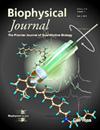Extrinsic heterogeneity: Collectivity in isotropic conformational fluctuations of chromosomes.
IF 3.2
3区 生物学
Q2 BIOPHYSICS
引用次数: 0
Abstract
Eukaryotic interphase chromosomes maintain a three-dimensional conformation within the nucleus and undergo fluctuations. However, the analysis of chromosome conformational fluctuations has been mainly limited to chromosome conformation capture data that record the contact frequencies between chromosomal regions. Herein, we investigated chromosome fluctuations as polymers based on experimental data from sequential fluorescence in situ hybridization (seqFISH)+ using a multiomics methodology. To describe the principal modes of chromosome fluctuations, we applied principal component analysis to the three-dimensional conformation information of single chromosomes in 446 mouse embryonic stem cells (mESCs) obtained from seqFISH+ data analysis for spatial genomics and signals of nuclear factors (histone marks, repeat DNAs, and proteins in interchromosomal nuclear compartments). We found that chromosome fluctuations exhibit both isotropic and anisotropic modes. The isotropic conformational fluctuations of all chromosome types tended to synchronize each other, reflecting extrinsic heterogeneity in chromosome conformation that is independent of the cell cycle. In contrast, anisotropic conformational fluctuations, occurring in a spindle-like shape, were associated with the interactions between repeat DNAs and nuclear factors. These results highlight the importance of dissecting cell cycle-independent nuclear organization based on the conformational folding of chromosomes and the interactions between genomic regions and nuclear factors.外在异质性:染色体各向同性构象波动的集体性。
真核间期染色体在细胞核内保持三维构象并经历波动。然而,对染色体构象波动的分析主要局限于记录染色体区域之间接触频率的染色体构象捕获数据。在此,我们基于序列荧光原位杂交(seqFISH)+的实验数据,使用多组学方法研究了染色体波动作为聚合物。为了描述染色体波动的主要模式,我们将主成分分析应用于446个小鼠胚胎干细胞(mESCs)的单染色体三维构象信息,这些信息来自seqFISH+空间基因组学数据分析和核因子信号(组蛋白标记、重复dna和染色体间核室中的蛋白质)。我们发现染色体波动具有各向同性和各向异性两种模式。所有染色体类型的各向同性构象波动倾向于彼此同步,反映了与细胞周期无关的染色体构象的外在异质性。相反,各向异性构象波动,以纺锤状形状发生,与重复dna和核因子之间的相互作用有关。这些结果强调了基于染色体构象折叠和基因组区域与核因子之间的相互作用解剖细胞周期独立核组织的重要性。
本文章由计算机程序翻译,如有差异,请以英文原文为准。
求助全文
约1分钟内获得全文
求助全文
来源期刊

Biophysical journal
生物-生物物理
CiteScore
6.10
自引率
5.90%
发文量
3090
审稿时长
2 months
期刊介绍:
BJ publishes original articles, letters, and perspectives on important problems in modern biophysics. The papers should be written so as to be of interest to a broad community of biophysicists. BJ welcomes experimental studies that employ quantitative physical approaches for the study of biological systems, including or spanning scales from molecule to whole organism. Experimental studies of a purely descriptive or phenomenological nature, with no theoretical or mechanistic underpinning, are not appropriate for publication in BJ. Theoretical studies should offer new insights into the understanding ofexperimental results or suggest new experimentally testable hypotheses. Articles reporting significant methodological or technological advances, which have potential to open new areas of biophysical investigation, are also suitable for publication in BJ. Papers describing improvements in accuracy or speed of existing methods or extra detail within methods described previously are not suitable for BJ.
 求助内容:
求助内容: 应助结果提醒方式:
应助结果提醒方式:


